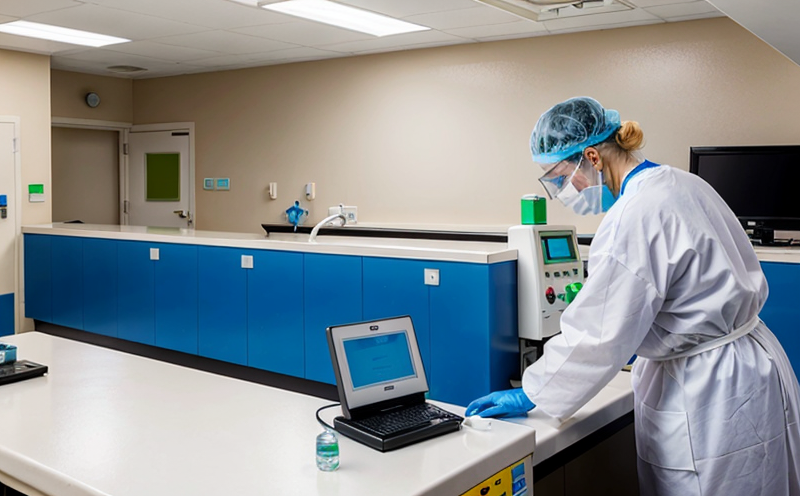Ethylene Oxide Sterilization Residue Testing in Medical Devices
In the healthcare sector, ensuring the safety and efficacy of medical devices is paramount. Ethylene oxide (EO) sterilization residue testing plays a critical role in this process by verifying that levels of EO residues are within acceptable limits to prevent potential health risks for patients. This service is essential for maintaining compliance with regulatory requirements such as ISO 17654:2013, which specifies the methods for determining ethylene oxide residues on medical devices.
The use of EO for sterilization has been widely adopted due to its effectiveness in killing microorganisms and its ability to penetrate complex geometries. However, residual levels of EO can remain on the surface of the device and pose health hazards if not adequately removed. Therefore, thorough testing post-sterilization is crucial.
The process involves several key steps: sample collection, preparation, analysis using advanced instrumentation such as gas chromatography (GC), and interpretation of results to ensure compliance with specified limits. This service caters specifically to hospitals and medical device manufacturers who need reliable data for quality assurance purposes.
Understanding the implications of EO residues is crucial for both regulatory bodies and end-users. High residual levels can lead to adverse health effects including irritation, sensitization, or even more severe conditions depending on individual sensitivity. Conversely, insufficient removal may result in incomplete sterilization, compromising the integrity of the device.
This service ensures that medical devices meet stringent standards set forth by relevant authorities like the FDA and WHO. By providing accurate measurements and detailed reports, it supports organizations in meeting their quality objectives while ensuring patient safety.
Scope and Methodology
| Step | Description |
|---|---|
| Sample Collection | Collected from various parts of the medical device, including critical surfaces where EO might be present. |
| Preparation | Pure ethanol is used to extract EO residues from the samples. This step ensures that only EO residues are analyzed and no other contaminants interfere with results. |
| Analysis | The extracted residues are then injected into a GC instrument for quantification. The column separates different components of the mixture, allowing precise measurement of EO levels. |
| Interpretation | Results from the analysis are compared against established standards to determine if the device is safe for use post-sterilization. |
The accuracy and precision of this testing process are critical. Rigorous quality control measures ensure that every sample analyzed meets stringent criteria, providing reliable data that can be used by stakeholders in decision-making processes.
It is important to note that while EO sterilization is highly effective, it also poses challenges due to its volatility. Proper handling and thorough residue testing help mitigate these risks, ensuring the safe use of medical devices across various healthcare settings.
Quality and Reliability Assurance
The quality and reliability assurance processes involved in EO sterilization residue testing are designed to provide accurate and consistent results. Our laboratories adhere strictly to internationally recognized standards such as ISO 17654:2013, ensuring that all tests conducted meet the highest scientific expectations.
Our team of experienced professionals uses state-of-the-art equipment to perform these tests with unparalleled accuracy. Each step from sample collection through final interpretation is meticulously documented and reviewed by our experts to ensure compliance with industry norms.
To further enhance reliability, we employ advanced quality control techniques including internal audits, proficiency testing programs, and continuous training for staff members. These measures guarantee that every test conducted reflects the true state of EO residues present on medical devices undergoing sterilization.
By maintaining such high standards, we not only support our clients in meeting regulatory requirements but also contribute to enhancing overall patient safety within healthcare institutions worldwide.
Customer Impact and Satisfaction
The impact of reliable EO sterilization residue testing extends beyond mere compliance; it significantly enhances customer satisfaction by ensuring that medical devices are safe for use. Hospitals, clinics, and other healthcare providers can trust our services to deliver accurate results consistently.
For quality managers and compliance officers responsible for overseeing the sterilization process, this service provides peace of mind knowing they have access to reliable data supporting their efforts towards maintaining optimal standards. R&D engineers benefit from detailed insights into how EO residues behave under different conditions, aiding in product development improvements.
Procurement teams appreciate having trusted partners who ensure that every medical device meets strict quality controls before reaching patients’ hands. By collaborating closely with us throughout the testing process, customers enjoy enhanced trustworthiness and efficiency in their operations.
In summary, our EO sterilization residue testing service plays an integral role in safeguarding public health while supporting efficient operational practices within healthcare settings.





